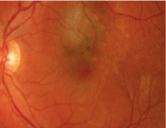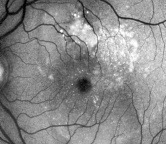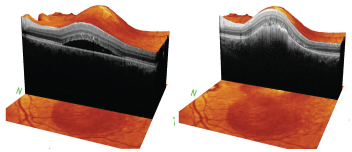 A 28-year-old white male presented complaining of distortion and decreased vision in his left eye that had persisted for a month. The patient, a commercial fisherman, has neither worn glasses nor reported any vision problems in the past. He is in excellent health and takes no medications.
A 28-year-old white male presented complaining of distortion and decreased vision in his left eye that had persisted for a month. The patient, a commercial fisherman, has neither worn glasses nor reported any vision problems in the past. He is in excellent health and takes no medications.
On examination, his entering acuity measured 20/20 O.D. and 20/50 O.S. Upon refraction, his best-corrected acuity demonstrated 20/30 O.S. His extraocular motility testing was normal. Confrontation visual fields were full to careful finger counting O.U. Amsler grid testing was normal O.D., but demonstrated central metamorphopsia O.S. His pupils were equally round and strongly reactive, with no afferent pupillary defect. The anterior segment examination was unremarkable.

1. Fundus photograph of our patients left eye. Note the lesion superior to the macula as well as the changes seen directly in the macula.
2. Another view of the posterior pole in our patients left eye, as seen on confocal scanning laser ophthalmoscopy.
The dilated fundus exam was completely normal in the right eye. In the left eye, the optic nerve was healthy, with a small cup and good rim coloration and perfusion. But, we noted a suspicious lesion approximately 1 disc diameter superior to the macula, as seen in figure 1. Other distinct findings can be seen on closer examination.

We obtained a confocal scanning laser ophthalmoscopy (cSLO) image (figure 2) and captured two slices of the patients left eye using spectral-domain optical coherence tomography (OCT) (figures 3 and 4). The peripheral examination was normal.

3,4. A Spectralis spectral-domain optical coherence tomography (
Take the Retina Quiz
1. What does the OCT cut through the macula (as seen in figure 3)?
a. Cystoid macular edema (CME).
b. Neurosensory detachment of the retina.
c. Retinal pigment epithelial (RPE) detachment.
d. Choroidal mass that is pushing up the macula.
2. What does the OCT cut superior to the macula (as seen in figure 4)?
a. CME.
b. Neurosensory detachment of the retina.
c. RPE detachment.
d. Choroidal mass that is pushing up the macula.
3. What is the most likely
diagnosis for this patient?
a. Choroidal nevus.
b. Choroidal melanoma.
c. Choroidal hemangioma.
d. Hemorrhagic RPE detachment secondary to choroidal neovascularization.
4. How should this patient be managed?
a. Observation.
b. Enucleation.
c. Plaque radiotherapy.
d. Intravitreal Avastin (bevacizumab, Genentech).
5. What is the likely overall prognosis for this patient?
a. Very poor.
b. Moderate.
c. Above average.
d. Excellent.
For answers, see below.
Discussion
Clinical examination of our patient reveals a neurosensory detachment of the macula O.S., which led to reduced acuity and distortion. The outline of this detachment can be visualized on cSLO. The detachment not only goes through his macula; it also extends inferiorly close to the inferior temporal arcade.
Additionally, the detachment can be seen on spectral domain OCT in figure 3. Figure 4 shows a similar elevation of the retina, but no serous detachment is visible in this cut. Instead, you can see a dome-shaped choroidal mass that seems to be pushing up the RPE and sensory retina. On clinical examination of this area, we detected a minimally-elevated pigmented lesion that appears to be the underlying cause of the serous retinal detachment.
Is the lesion cancerous? Unfortunately, the diagnosis is somewhat uncertain because of the lesions small size. The biggest concern: Could this anomaly be a small choroidal melanoma, or is it simply a choroidal nevus? When pigmented lesions are this small, it can be very difficult to distinguish between the two. Standard ultrasound can usually help, but for lesions that are less than 2mm in elevation, the ultrasound cannot accurately differentiate based on reflectivity.
Still, there are reasons for concern based on the clinical appearance. If you look carefully, there are some features that suggest this lesion may be an early choroidal melanoma.The observed elevation makes the lesion somewhat suspicious. Also, there are some small areas of orange pigment overlying the lesion. Orange pigment in the presence of a pigmented lesion is very indicative of lipofuscin, which is highly diagnostic for a choroidal melanoma. Lipofuscin is not a good prognostic sign and usually indicates the potential for rapid growth.1,2
The OCT provides some important prognostic information. Choroidal melanomas and nevi generally image poorly with OCT, as the technology does not differentiate tissues on a histopathologic level. However, overlying subretinal fluid in suspicious pigmented lesions is a risk factor for eventual growth.3 So, the presence of subretinal fluid in the pigmented lesion may have predictive value in identifying melanocytic lesions that may grow.
Given this information, our patient likely has a small choroidal melanoma that has been discovered very early. We elected to observe the lesion until we can confirm with near certainty that he has a choroidal melanoma.
Observation without treatment for a lesion of this size does not seem to affect the overall prognosis from a mortality perspective. In the small arm of the Collaborative Ocular Melanoma Study (COMS), investigators were given a choice to observe or treat patients who had small melanomas.4 In their series of 204 subjects with small choroidal melanoma, merely 8% of the patients were immediately treated at the time of diagnosis, and an additional 33% were treated during the follow-up.
Only six reported deaths were linked to metastic melanoma. The investigators noted that otherwise healthy patients with small choroidal lesions (melanoma) have a low risk of dying within five years of initial detection.4
Even though we have not yet treated the melanoma, we gave the patient an intravitreal Avastin injection that we hoped would heal his serous detachment and restore normal visual function in his left eye.
Avastin has been shown to be effective in reducing macular edema, particularly in those patients who have had radiation-induced macular edema. This is logical because Avastin inhibits pathologic neovascularization and reduces capillary permeability. In the absence of vascular permeability, it is unknown how the serous detachment will respond to the Avastin injection. The patient is scheduled to return for follow-up in six to eight weeks.
1. Shields CL, Shields JA, Kiratli H, et al. Risk factors for growth and metastasis of small choroidal melanocytic lesions. Ophthalmology 1995 Sep;102(9):1351-61.
2. Shields CL, Cater JC, Shields JA, et al. Combination of clinical factors predictive of growth of small choroidal melanocytic tumors. Arch Ophthalmol 2000 Mar;118(3): 360-4.
3. Espinoza G, Rosenblatt B, Harbour JW. Optical coherence tomography in the evaluation of retinal changes associated with suspicious choroidal melanocytic tumors. Am J Ophthalmol 2004 Jan;137(1):90-5.
4. Mortality in patients with small choroidal melanoma. COMS report no. 4. The Collaborative Ocular Melanoma Study Group. Arch Ophthalmol 1997 Jul;115(7):886-93.
Retina Quiz Answers: 1) b; 2) d; 3) b; 4) a; 5) d

